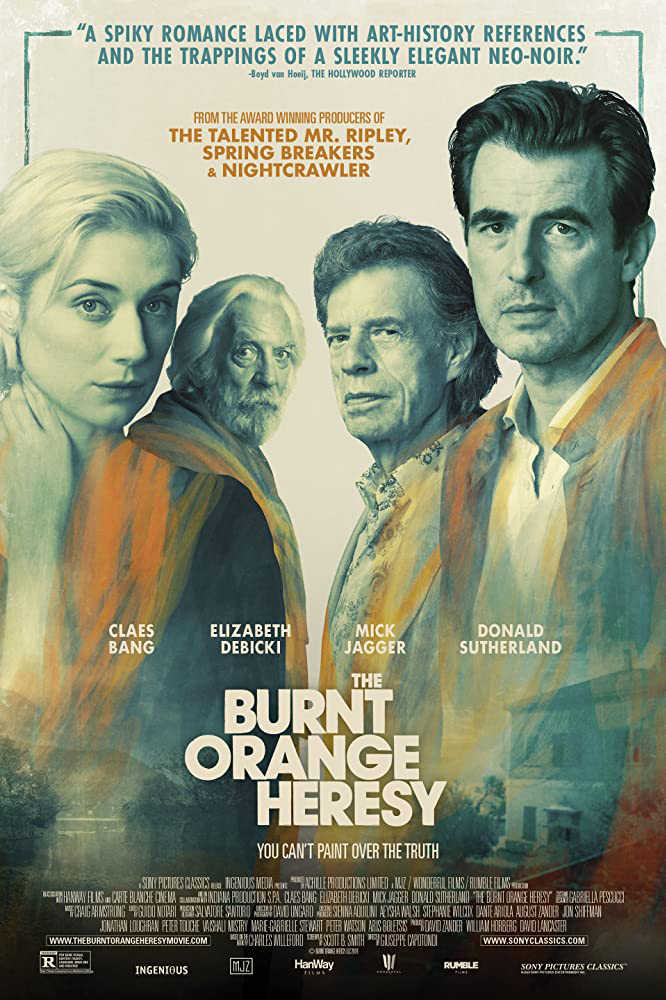If viewed as an allegory, or as a film with any philosophical profundities to offer about the world, “The Burnt Orange Heresy” seems to collapse before our eyes. Somewhere in Italy, maybe in 2019 – maybe in 1990, time seems immaterial here – Berenice Hollis (Elizabeth Debicki), an American tourist, wanders into a lecture on art criticism by suave art critic, James Figueras (Claes Bang). The lecture is both peripheral and yet incredibly essential in a weird paradox that marks much of what will come later. The camera cuts between James’ eclectic lecture, and his effortful practice for the lecture – which amounts to the half-banal, half-thoughtful observation that our emotional interest in art is merely contextual. It’s never about the art, it’s about the story behind the art. Context is everything. Meaning is relative. And truth is illusory. Later in the film, a famed artist repeats something that’s vaguely similar. The observations are just intriguing enough that they could launch a series of profounder conversations after the film but also innocuous enough that they don’t seem to hold up to much scrutiny on further thought. The relationship between art, forgery and truth is ripe for philosophical engagement. But, “The Burnt Orange Heresy” is not really offering much profundity in that plane. Instead, it entices in the way that Giuseppe Capotondi’s sleek and languorous direction of a world that seems removed from real-world stakes presents a tale of beautiful, tall people being increasingly venal or idle. Or both.
Three words into their conversation at that lecture, we know that James and Berenice will end up in bed. And Capotondi gets to the moment early on. The way he frames that first extended sex-scene capitalises on the length of their bodies – Bang is 6’4”, while Debicki is 6’3”. In another film they might be playing a high-society couple. Here, though, they are achingly normal. He is a washed-up art-critic with money struggles. She is a cypher of an American, increasingly reticent about explaining her reason for being in Italy. Their casual meeting indicates that their sexual encounter is merely temporary. But they’re charmed by each other so much that James invites her as his plus-one for what he calls a fancy art party, but is really a weekend away at a reclusive art-collector’s house. As the pair wander around the picturesque villa, “The Burnt Orange Heresy” seems to be idly marking time, plot wise. For much of the first 25-minutes it reveals little about its purpose, and yet the nonchalance in tone is alluring.
When their host, a devilishly macabre Mick Jagger who makes the most of his brief screen time, sets up the reason for the invite and the film’s complication – James has an opportunity to interview a famed, reclusive artist and restart his wavering career once he satisfies their host’s inappropriate demands – the moment is treated with all the casualness of an offhand remark. That nonchalance becomes key in the waves of impish misdirection that will come. We even forget them briefly as we watch Bang and Debicki relax beside the pool of this rich-collector’s house. We imagine, for a moment, that they even fit in there. And then Donald Sutherland, another tall person at 6’2, saunters into the film as a mordant artist, and the film – and its antihero – begins to unravel in ridiculous and enticing ways.
For long stretches “The Orange Burnt Heresy” is merely a series of scenes of people talking at each other. Bang, Debicki, Jagger and Sutherland are the only named characters with more than a few lines. Yet, while watching it, the film never feels particularly beholden to dialogue or especially interested in words. It’s not even until the first appearance of blood, an accidental bloody nose to James – that we remember that this is a thriller. Or could be a thriller. Even on this Capotondi is ambivalent. From the get-go he needles at us, suggesting that something is wrong, and Scott Smith’s deliberate screenplay archly sets up a series of call-backs that will be important. But this is all more playfully, languorously arch – and then playfully, languorously cruel, than truly propulsive. Which feels like a strange description of a maybe-maybe-not thriller.
When Sutherland’s Jerome Debney wanders off for a stroll with Berenice, the conversation feels like it should be important but also incredibly inconsequential. It’s a recurring trend in the film. The whirlwind sexcapade between Berenice and James feels casual but also as if it’s built on something else. Even James’ neurotic obsession with Debney’s art, an artist famous for losing all his works in infamous fires, feels like it’s hiding something we don’t quite know. It’s part of Capotondi playfulness which feels deliberately diffident, as if letting us in on a joke, even if we’re not always sure of the punchline.
Two significant crimes are committed towards the end – the first against property, the second against a person. And both occur in such swift, almost jarring, ways that at first feel too ridiculous to have happened. But they have, and they do. Capotondi shrugs at their impact, for the most part. Inviting us to be amused but not too invested in these people. There’s an artifice to everything they do, baked into the film’s own musings on artifice in art. But the fact that nothing in “The Burnt Orange Heresy” registers as lifelike becomes the charm. It’s so sure of itself, in all its languor, that the way it ambles from casual art-examination, to dark-perverse tales of artifice, feels both natural and overwrought. It’s built on paradoxes, but the actors – particularly Debicki – commit to the film’s wavelength in ways that are too charming to resist. Like the painting at its centre that gives the film its title, it’s not as profound as it makes itself out to be – deliberately so. That’s part of the allure.
The Burnt Orange Heresy is available for streaming on Vudu, Amazon Prime Video and other digital platforms.












